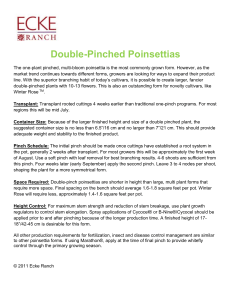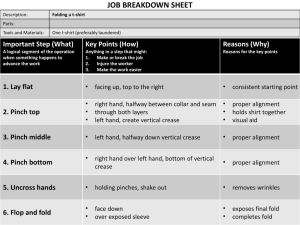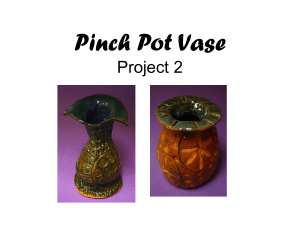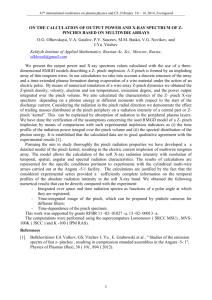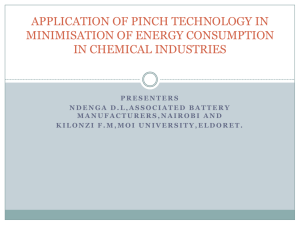Water Pinch Analysis
advertisement
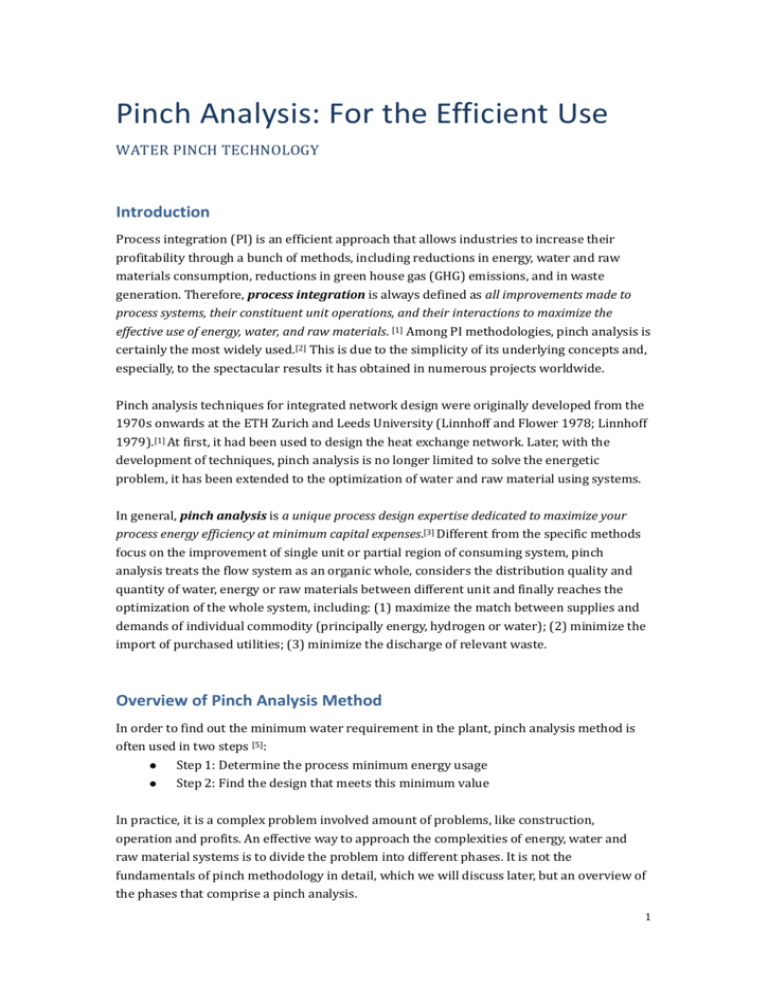
Pinch Analysis: For the Efficient Use WATER PINCH TECHNOLOGY Introduction Process integration (PI) is an efficient approach that allows industries to increase their profitability through a bunch of methods, including reductions in energy, water and raw materials consumption, reductions in green house gas (GHG) emissions, and in waste generation. Therefore, process integration is always defined as all improvements made to process systems, their constituent unit operations, and their interactions to maximize the effective use of energy, water, and raw materials. [1] Among PI methodologies, pinch analysis is certainly the most widely used.[2] This is due to the simplicity of its underlying concepts and, especially, to the spectacular results it has obtained in numerous projects worldwide. Pinch analysis techniques for integrated network design were originally developed from the 1970s onwards at the ETH Zurich and Leeds University (Linnhoff and Flower 1978; Linnhoff 1979).[1] At first, it had been used to design the heat exchange network. Later, with the development of techniques, pinch analysis is no longer limited to solve the energetic problem, it has been extended to the optimization of water and raw material using systems. In general, pinch analysis is a unique process design expertise dedicated to maximize your process energy efficiency at minimum capital expenses.[3] Different from the specific methods focus on the improvement of single unit or partial region of consuming system, pinch analysis treats the flow system as an organic whole, considers the distribution quality and quantity of water, energy or raw materials between different unit and finally reaches the optimization of the whole system, including: (1) maximize the match between supplies and demands of individual commodity (principally energy, hydrogen or water); (2) minimize the import of purchased utilities; (3) minimize the discharge of relevant waste. Overview of Pinch Analysis Method In order to find out the minimum water requirement in the plant, pinch analysis method is often used in two steps [5]: Step 1: Determine the process minimum energy usage Step 2: Find the design that meets this minimum value In practice, it is a complex problem involved amount of problems, like construction, operation and profits. An effective way to approach the complexities of energy, water and raw material systems is to divide the problem into different phases. It is not the fundamentals of pinch methodology in detail, which we will discuss later, but an overview of the phases that comprise a pinch analysis. 1 Figure 1 shows a breakdown of tasks normally performed during a typical pinch study. The dark blue (heavily shaded) boxes are main activities; the light blue (lightly shaded) boxes are activities that can be used in separate or combination. Figure1. Structured Approach of Pinch Analysis DATA COLLECTION Design Data Simulation Measurements MODELING PINCH ANALYSIS ITERATIVE SOLUTION PROJECT IDEAS Measurements Site Expertise Simulation PI Experience SITE IMPROVEMENT In the data collection phase, all three types of data are valuable for performing a pinch analysis: Measurements are the most appropriate basis for evaluation, which define the process currently in operation. Simulation is the best data source for a study, which includes the previous category and a consistent usage and consumption balance. Design data may be used where Measurements cannot be preformed. Project ideas need to be evaluated with one or more methods and then adjust these ideas though modeling process. This may be an iterative solution, because all these processes may be repeated several times. Water Pinch Analysis Water Pinch Analysis (WPA) is a systematic technique for reducing water consumption and wastewater generation through integration of water-using activities or processes. [2] Key target of water pinch analysis is maximizing water reuse and minimizing the amount of wastewater. Techniques for setting targets for maximum water recovery capable of handling any type of 2 water-using operation including mass-transfer-based and non-mass-transfer based systems include the source and sink composite curves and water cascade analysis (WCA).[3] The source and sink composite curves is a graphical tool for setting water recovery targets as well as for design of water recovery networks.[4] It considers each water-using operation as being described by the mass transfer of a certain contaminant(s) from the process itself to the water stream (Figure.2a). First of all, in order to achieve a better understanding of the composite curves, a single water using unit is analyzed in this section. Figure.2 (a) Model of Mass Transfer in Water Using Unit (b) Loading and Concentration Figure (a) Limiting Water Supply Line Water Supply Line (b) This process can also be described by the C-M figure (Figure.2b). The horizontal ordinate M represents the contaminant mass loading, while vertical ordinate C is the contaminant concentration. The highest concentration, which is also the highest line in C-M figure, is the contaminant line; the other lower lines are water supply lines. The larger the slope of water supply line is, the smaller the flowrate of the supplied water will be. In order to determine whether the recovered water can be used in the specific unit, maximum inlet contaminant concentration (C In, Max) should be provided, which is named as limiting inlet concentration. 3 And, in order to certify the minimum inlet flowrate, the maximum outlet flowrate (C Out, Max) is needed. With these two values, the limiting water supply line is certified (the first solid line under the contaminant line in Figure.2b). From Figure 2b, we can see that any water supply line under limiting water supply line can meet the requirement of the water using unit. It is the explanation of single unit analysis, which is also a component of a whole water pinch analysis. In order to optimize the whole system, we need to consider the water using condition entirely. Therefore, it requires us to recombine all the composite curves as one curve and analyzed this integrative curve. The detailed process is show in Figure.3. Figure.3 Composite Curve and Limiting Composite Curve 4 □ 3 □ 1 □ 2 □ 1 2 4 3 4 By specifying the maximum allowable inlet and outlet contaminant concentrations for each operation unit, a composite curve of all the units is built (Figure.3.1). Then, on the basis of the composite curve, a limiting profile can be constructed. These are combined to form a limiting composite curve (Figure.3.3, 3.4), against which a water supply line can be matched. As we mentioned before, the entire water supply curve which are underneath the limiting composite curve can meet the requirements of water using in the units. We assume the inlet concentration of the fresh water is zero. In order to minimize the consumption of fresh water, the outlet concentration should be as large as possible. When the slope of the water supply curve increases to touch the limiting composite curve, the mass transfer driving force is minimum, outlet concentration is maximum, and consumption of the fresh water is minimum. This touching point is the water pinch point, as shown in Figure.3.4. Water pinch point has a significant meaning for the water system design. Above the water pinch point, limiting inlet concentration of the unit is larger than the pinch point concentration, there’s no need for the unit to use fresh water. Blow the water pinch point, limiting outlet concentration is smaller than the pinch point concentration, the wastewater in this unit should not be discharged, since it can be reused as the inlet water of the other unit after some treatment or directly. Application of Water Pinch Point There are several types of water reuse solutions, with or without water treatment. One of a simple solution is: a water pinch study begins with the assumption that existing inlet concentrations (concentration of water sinks) are at their maximum acceptable limits for all site processes/equipments. This indicates the minimum water usage under currently imposed constraints on inlet concentrations. Projects identified at this stage will be low-cost opportunities involving only pipework modifications, but generally allowing only small water reuse opportunities. Figure.4 One Design of Water Reuse 5 Based on this water pinch analysis, continue to use the example above, the total saving percentage of the fresh water and the reduction of the wastewater can be figured out, which is nearly 23% (Figure.4). Reference [1] Linnhoff, B., 1993. Pinch analysis: a state-of-the-art overview. Trans. I Chem E (Part A) .71, 503_522. [2] Polley, G.T., Polley, H.L., 2000. Design better water networks. Chem. Eng. Prog 96 (2)., 47_52. [3] Savelski, M.J., Bagajewicz, M.J., 1999. WaterSave: a New Approach to the Design of Water Utilisation Systems in Refineries and Process Plants. AIChE Spring Meeting, Houston. [4] Kim K J,Smith R.Automated design of diacontinuous water system[J].Process Safety and Environmental Protection,2004.82(3):238—248. [5] Wang, Y.P., Smith, R., 1994. Wastewater minimisation. Chem. Eng. Sci. 49, 981_1006. Ran Zhao Factsheet 2 6

